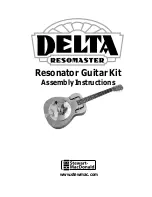
page 8
the tail block for the strap button mounting screw that holds
the tailpiece. If the tail block is quite snug, leave it installed
from now on. If it is on the loose side, which is OK, it might
rattle around. In that case remove it until you mount the
tailpiece.
The neck block also must be radiused at the front top and
bottom edges so that it fits exactly into the rolled corners
where the sides meet the top and back. It must have a 1/4"
tall, 3/32" deep channel cut into the top front edge to allow
it to rest over the folded solder joint of the top and sides.
The body tapers slightly, getting narrower at the neck end. To
fit the neck block, stand it upright at the soundwell and push
it into place.
The neck joint is a bolt-on mortise-and-tenon joint. The
tenon is the precision-cut extension on the end of the neck,
and the mortise is the neck block recess which fits it. The
neck’s tenon needs to be trimmed to fit into the neck open-
ing in the metal body. It’s a simple task:
Along the sides of the tenon, mark down from the top edge
approximately 5/16" and draw a pencil line square to the
cheeks
(the “cheeks” are described below)
. Measure the
lip of metal in the body’s neck-mounting hole and give a lit-
tle extra for clearance). Also make a pencil line about 3/8" up
from the bottom (again, match the hole plus a bit extra for
clearance).
Saw in from the back of the tenon on each penciled line
(14)
.
Avoid touching the cheeks with the saw — stop short, and
clean up later with a sharp chisel. Then saw squarely down
from the top, and up from the bottom, to each sawed line
and the piece will break out. The tenon is now shaped
(15)
and will fit through the rectangular hole in the body.
Fitting the neck to the body
14.
Saw in from the back of the tenon on each penciled line.
15.
The tenon will now fit through the rectangular hole in the
body.
Before gluing the fingerboard onto the neck, it’s best to
check the fit of the neck to the body, for two reasons: 1) It’s
easier to fit the heel without the fretboard getting in the way;
2) The fretboard can be placed most accurately, with regard
to correct intonation,
after
any slight adjustments of the heel
have been made.
The neck is machined with the correct “set,” or angle to the
body, but as with any guitar — wood or metal — some hand
fitting may be required. Also, when you shape the heel of the
neck, we suggest that you leave it “chunky” — almost as it
comes out of the box. Just round off the hard edges. This pro-
vides plenty of wood for the neck bolts to hold into, and adds
strength to the neck/body joint. (It’s also the vintage look.)
Check the fit










































